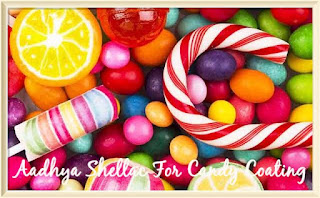Food Glaze or
Confectioners or Candy Glaze is an alcohol-based solution of various types of food-grade
shellac. When used in food and confections, it is also known as confectioner's
glaze, resinous glaze, pure food glaze, natural glaze, or confectioner's resin.
Confectioner’s glaze used for candy contains roughly 35% shellac, while the
remaining components are volatile organic compounds that evaporate after the
glaze is applied.
When used in food and
confections, shellac has the food additive number E904, and is described on
food labels as ‘confectioner’s glaze’, ‘confectioner’s resin’, ‘resinous
glaze’, ‘candy glaze’, ‘pure food glaze’ and ‘natural glaze’.
Flavor:
- The main uses of shellac in confectionery are to do
with coating chocolate goods, such as candy-covered nuts and raisins, and
similar products. But what many people may not realize is that it’s also
used as a coating on some nutritional supplements, medicines, fruit, and
even coffee beans.
- Shellac is labeled as GRAS (generally recognized as
safe) by the US FDA and is used as glaze for several types of foods,
including some fruit, coffee beans, chewing gum, and candy. Examples of
candies containing shellac include candy corn, Hershey's Whoppers and Milk
Duds, Nestlé's Raisinets and Goobers, Tootsie Roll Industries’ Junior
Mints and Sugar Babies, Jelly Belly's jelly beans and Mint Cremes, Russell
Stover's jelly beans, and several candies by Godiva Chocolatier and
Gertrude Hawk. M&;M's do not contain shellac.
·
Natural Glaze or Resinous Glaze or Food
Glaze or Confectioners Glaze or Pharmaceutical glaze is an alcohol-based
solution of various types of food-grade shellac. When used in food and confections, it is
also known as confectioner's
glaze, resinous glaze, pure food glaze, natural glaze,or confectioner's resin.
·
Food Glaze or Confectioners Glaze or
Pharmaceutical glaze may
contain 20–51% shellac in solution in ethyl alcohol (grain alcohol) that has not been denatured
(denatured alcohol is poisonous), waxes, and titanium dioxide as
an opacifying agent. Confectioner’s glaze used for candy contains roughly 35%
shellac, while the remaining components are volatile organic compounds that
evaporate after the glaze is applied.
·
Food Glaze or Confectioners Glaze or
Pharmaceutical glaze is used
by the drug and nutritional supplement industry as a coating material for tablets
and capsules. It serves to improve the product's appearance, extend shelf life and protect it from moisture, as well as
provide a solid finishing film for pre-print coatings. It also serves to mask
unpleasant odors and aid in the swallowing of the tablet.
·
The shellac coating is insoluble in stomach acid and may make
the tablet difficult for the body to break down or assimilate. For this reason,
it can also be used as an ingredient in time-released, sustained or
delayed-action pills. The product is listed on the U.S. Food
and Drug Administration's (FDA) inactive ingredient list.
·
Shellac is labeled as GRAS (generally
recognized as safe) by the US FDA and is used as glaze for several types of foods,
including some fruit, coffee beans, chewing gum, and candy. Examples of candies
containing shellac include candy corn, Hershey's Whoppers and Milk Duds, Nestlé's Raisinets and Goobers, Tootsie Roll Industries's Junior Mints and Sugar Babies, Jelly Belly's jelly beans and Mint Cremes, Russell Stover's jelly beans, and
several candies by Godiva Chocolatier and Gertrude Hawk. M&M's do not contain shellac.





























No comments:
Post a Comment